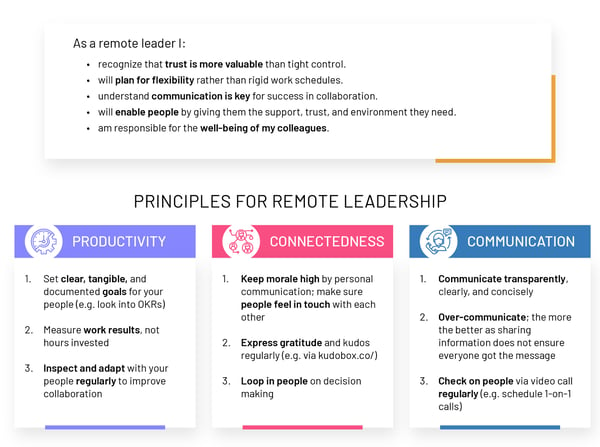While every employee faces some challenges in adjusting to the shift towards working from home, this change presents even more tests for those in leadership positions. In a traditional setup, the role of managers is often to organize, instruct, and control the work of their teammates to ensure high productivity and alignment towards company goals. As discussed in the previous parts of this series, some of these responsibilities have shifted towards the team or the individual. Employees are self-responsible for ensuring their productivity, work planning, and alignment. In such a scenario, what is the role of leadership in a remote setup?
Remote working leadership manifesto
When working remotely, the main responsibility of the leadership is to ease communication, enable people, and be caring. You will have to adapt your behavior in leading, just like your employees must adapt their behavior in collaborating. Physical distance makes it harder to drop by and see how people are doing, or to casually check how a team is doing and what their goals are.
Based on our experience, we have observed some highly effective core guidelines on leadership behavior. I distilled these down to five essential statements, that apply to leading from home:
As a remote leader, I:
-
Recognize that trust is more valuable than tight control
Working from home increases the autonomy and self-responsibility of employees. While some managers prefer to base their leadership on tight cycles of checks, this won’t be possible under the current circumstances. Given the physical distance, it is much harder to control people – and it’s not beneficial at all. Even if it seems strange, providing people with more trust and freedom will pay off very quickly. So, instead of tight control, give more autonomy. Try goal-setting frameworks (e.g., OKRs) to align on clear goals, but let them work out how to achieve these goals. Your job is to ease things and enable better productivity. And you might be surprised at how much work they can do on their own.
-
Will plan for flexibility rather than rigid work schedules
Work and private life can sometimes mingle. Observing people working from home also shows that everyone has their pace (and space!). While it is natural to share most of our core hours when in office, it gets comparatively relaxed in a remote setup. Primarily, there is a lot of social benefit in being more flexible. Just think about the prospect of having breakfast with your family. You might start working a bit later or even work a bit before breakfast, and then take a short break. The same applies to lunch and at other times. These small breaks are vital to easing the cognitive load. Also, people may take a few hours off to get groceries or attend other appointments. This intermingling of private and work life is not something you can argue with. It is bound to happen. Instead of judging people by the time they invest (or are online), evaluate their work results. Of course, people must be available during office hours. Still, the results are more relevant than the time invested. Align on common agreements but plan for personal flexibility as well. It will pay off in more balanced stress-levels and also in high intrinsic motivation, as human beings have different needs.
-
Understand that communication is the key to successful collaborations
This is something one can never emphasize enough in the context of working from home. As we are physically distant, we need to be closer when communicating. Further, a lot can get lost in translation when we converse mostly by writing or (video) calls. There is so much subtext we don’t easily get when we only see someone. When communicating in this setup, you need to be more expressive. Elaborate more on the context when sharing information. Tell people how you reached the conclusions and why they are important. It is easy to assume that everyone shares your views, even more when you are not physically close to them. So, you’d much rather over-communicate. And don’t hide anything! Be transparent, clear and concise to prevent misunderstandings or bad assumptions. Share as much as possible!
-
Will enable people by giving them the support they need
This is the core responsibility when leading from home. As the responsibility of achieving the targeted results and getting stuff done gets shifted towards the individual employee, the role of leadership is heavily focussed on support. Being physically disconnected, it is easy to overlook individual needs and blockers. So, this is your prime responsibility as a leader: Help people to be as productive and effective as possible. Get in touch with your colleagues to check how they are doing or what they need. Loop them in, when making decisions, to cover their view. Try to engage with employees on different levels.
Another effective technique is to set up recurring meetings to inspect and adapt with your teams. They can be as elaborate as a scrum retrospective, or even a simple bi-weekly call to figure out what is working and what can be improved. In any case, it is your job to act and foster these results. Make sure that everyone in your team has everything they need.
-
Am responsible for the well-being of my colleagues
Keep in mind, that as a leader, you are the link between people. You create the culture in your team or company. To contribute to a healthy culture and a well-performing organization, do focus on the well-being of your colleagues. This is especially important in a remote setup where people are disconnected. You can’t simply join in for a quick coffee and keep talking without establishing a connect. Each emotion gets more intense in this setup, and team morale can swing more swiftly than when offline. So make sure that you keep the morale of your team high by communicating regularly and having a pulse on their emotions. Make sure that people feel in touch with each other. Set up regular chit-chat calls and check-in on people in one-on-ones. Listen to stories of individual success, failure, and needs. Make sure that the contribution and needs of everyone in your team are visible. You can even step up your support if you think someone seems down or stressed. Setting such an example of being a caring and empathetic leader can inspire a lot of confidence, trust and respect.
Last but certainly not the least, my most important tip is: Focus on expressing gratitude! Set up virtual Kudoboards or use something like virtual bonus money or nominations for ‘appreciation of the week’ to generate a positive buzz. It makes contributions visible and provides feedback loops. When practiced sincerely by a leader, expressing gratitude is a simple thing that builds high-performing culture!
Wrap up
Leading from home is quite a challenge. There is so much distance to cover by expressive communication, listening, and showing action. Acting as an example of the remote culture you want to have is the greatest thing you can do. As a leader, your role shifts towards connecting and caring for your people.
Do keep these five guiding principles in mind as the cornerstones for effective leadership while working remotely:
- Trust people to do the right thing
- Stay flexible
- Communicate often, regularly and clearly
- Enable and support your people
- Be caring
Here are the tips for leading from home, summarized for a quick glance:





